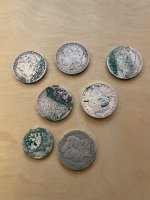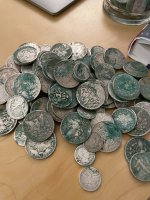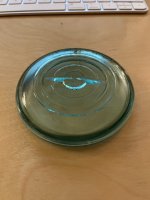Rochambeau
Tenderfoot
- Jan 2, 2022
- 5
- 35
Hey all, brand new here... I recently unearthed 10 pounds of Morgan dollars, a few quarters, and some dimes, all dated from 1878 to 1915 or so. The coins were buried about 2 feet deep in a large glass jar with a wire cage to pin down the lid. I'm pretty certain the jar was already broken by the time my shovel found it, but I pulled out about 200 coins. I have a couple of questions...
The original owner of the property where these coins were found owned the property from 1895 to 1941. He was a boat captain (I have photographs of him and his registration card from the local marina) and I suspect he buried some of his money on his property. The next door neighbor has been here since the mid 50s and told me the kids that lived here after the captain found a double eagle under one of the trees in the back yard. I think there is a reasonable chance there are more buried jars. I'm looking for recommendations on a metal detector that will scan a couple of feet down.
Every single one of the coins has pretty heavy green corrosion and a few have dark purple corrosion. Pictures attached. I took a couple of the coins to a dealer and they told me the coins have been obviously cleaned and are only worth their melt value. It's certainly not true. I gently rinsed the coins in warm water to get the dirt off them and have them sitting in a jar. Many of the coins are stuck together. Is there any way to remove the corrosion without damaging the value of the coins?
Thanks for your advice!
The original owner of the property where these coins were found owned the property from 1895 to 1941. He was a boat captain (I have photographs of him and his registration card from the local marina) and I suspect he buried some of his money on his property. The next door neighbor has been here since the mid 50s and told me the kids that lived here after the captain found a double eagle under one of the trees in the back yard. I think there is a reasonable chance there are more buried jars. I'm looking for recommendations on a metal detector that will scan a couple of feet down.
Every single one of the coins has pretty heavy green corrosion and a few have dark purple corrosion. Pictures attached. I took a couple of the coins to a dealer and they told me the coins have been obviously cleaned and are only worth their melt value. It's certainly not true. I gently rinsed the coins in warm water to get the dirt off them and have them sitting in a jar. Many of the coins are stuck together. Is there any way to remove the corrosion without damaging the value of the coins?
Thanks for your advice!





 I would say go see if any more jars can be found. Then sort through all the comments for best advice. The very fact, coin dealer accused you of cleaning them... maybe a clue the coins are better if left tarnished?
I would say go see if any more jars can be found. Then sort through all the comments for best advice. The very fact, coin dealer accused you of cleaning them... maybe a clue the coins are better if left tarnished?


